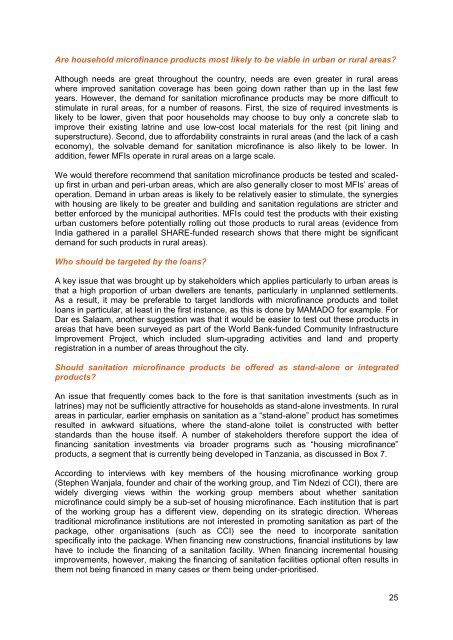REPORT__Evaluating_the_potential_of_microfinance_for_sanitation_in_Tanzania_May_2013
REPORT__Evaluating_the_potential_of_microfinance_for_sanitation_in_Tanzania_May_2013
REPORT__Evaluating_the_potential_of_microfinance_for_sanitation_in_Tanzania_May_2013
Create successful ePaper yourself
Turn your PDF publications into a flip-book with our unique Google optimized e-Paper software.
Are household micr<strong>of</strong><strong>in</strong>ance products most likely to be viable <strong>in</strong> urban or rural areas?<br />
Although needs are great throughout <strong>the</strong> country, needs are even greater <strong>in</strong> rural areas<br />
where improved <strong>sanitation</strong> coverage has been go<strong>in</strong>g down ra<strong>the</strong>r than up <strong>in</strong> <strong>the</strong> last few<br />
years. However, <strong>the</strong> demand <strong>for</strong> <strong>sanitation</strong> micr<strong>of</strong><strong>in</strong>ance products may be more difficult to<br />
stimulate <strong>in</strong> rural areas, <strong>for</strong> a number <strong>of</strong> reasons. First, <strong>the</strong> size <strong>of</strong> required <strong>in</strong>vestments is<br />
likely to be lower, given that poor households may choose to buy only a concrete slab to<br />
improve <strong>the</strong>ir exist<strong>in</strong>g latr<strong>in</strong>e and use low-cost local materials <strong>for</strong> <strong>the</strong> rest (pit l<strong>in</strong><strong>in</strong>g and<br />
superstructure). Second, due to af<strong>for</strong>dability constra<strong>in</strong>ts <strong>in</strong> rural areas (and <strong>the</strong> lack <strong>of</strong> a cash<br />
economy), <strong>the</strong> solvable demand <strong>for</strong> <strong>sanitation</strong> micr<strong>of</strong><strong>in</strong>ance is also likely to be lower. In<br />
addition, fewer MFIs operate <strong>in</strong> rural areas on a large scale.<br />
We would <strong>the</strong>re<strong>for</strong>e recommend that <strong>sanitation</strong> micr<strong>of</strong><strong>in</strong>ance products be tested and scaledup<br />
first <strong>in</strong> urban and peri-urban areas, which are also generally closer to most MFIs’ areas <strong>of</strong><br />
operation. Demand <strong>in</strong> urban areas is likely to be relatively easier to stimulate, <strong>the</strong> synergies<br />
with hous<strong>in</strong>g are likely to be greater and build<strong>in</strong>g and <strong>sanitation</strong> regulations are stricter and<br />
better en<strong>for</strong>ced by <strong>the</strong> municipal authorities. MFIs could test <strong>the</strong> products with <strong>the</strong>ir exist<strong>in</strong>g<br />
urban customers be<strong>for</strong>e <strong>potential</strong>ly roll<strong>in</strong>g out those products to rural areas (evidence from<br />
India ga<strong>the</strong>red <strong>in</strong> a parallel SHARE-funded research shows that <strong>the</strong>re might be significant<br />
demand <strong>for</strong> such products <strong>in</strong> rural areas).<br />
Who should be targeted by <strong>the</strong> loans?<br />
A key issue that was brought up by stakeholders which applies particularly to urban areas is<br />
that a high proportion <strong>of</strong> urban dwellers are tenants, particularly <strong>in</strong> unplanned settlements.<br />
As a result, it may be preferable to target landlords with micr<strong>of</strong><strong>in</strong>ance products and toilet<br />
loans <strong>in</strong> particular, at least <strong>in</strong> <strong>the</strong> first <strong>in</strong>stance, as this is done by MAMADO <strong>for</strong> example. For<br />
Dar es Salaam, ano<strong>the</strong>r suggestion was that it would be easier to test out <strong>the</strong>se products <strong>in</strong><br />
areas that have been surveyed as part <strong>of</strong> <strong>the</strong> World Bank-funded Community Infrastructure<br />
Improvement Project, which <strong>in</strong>cluded slum-upgrad<strong>in</strong>g activities and land and property<br />
registration <strong>in</strong> a number <strong>of</strong> areas throughout <strong>the</strong> city.<br />
Should <strong>sanitation</strong> micr<strong>of</strong><strong>in</strong>ance products be <strong>of</strong>fered as stand-alone or <strong>in</strong>tegrated<br />
products?<br />
An issue that frequently comes back to <strong>the</strong> <strong>for</strong>e is that <strong>sanitation</strong> <strong>in</strong>vestments (such as <strong>in</strong><br />
latr<strong>in</strong>es) may not be sufficiently attractive <strong>for</strong> households as stand-alone <strong>in</strong>vestments. In rural<br />
areas <strong>in</strong> particular, earlier emphasis on <strong>sanitation</strong> as a “stand-alone” product has sometimes<br />
resulted <strong>in</strong> awkward situations, where <strong>the</strong> stand-alone toilet is constructed with better<br />
standards than <strong>the</strong> house itself. A number <strong>of</strong> stakeholders <strong>the</strong>re<strong>for</strong>e support <strong>the</strong> idea <strong>of</strong><br />
f<strong>in</strong>anc<strong>in</strong>g <strong>sanitation</strong> <strong>in</strong>vestments via broader programs such as “hous<strong>in</strong>g micr<strong>of</strong><strong>in</strong>ance”<br />
products, a segment that is currently be<strong>in</strong>g developed <strong>in</strong> <strong>Tanzania</strong>, as discussed <strong>in</strong> Box 7.<br />
Accord<strong>in</strong>g to <strong>in</strong>terviews with key members <strong>of</strong> <strong>the</strong> hous<strong>in</strong>g micr<strong>of</strong><strong>in</strong>ance work<strong>in</strong>g group<br />
(Stephen Wanjala, founder and chair <strong>of</strong> <strong>the</strong> work<strong>in</strong>g group, and Tim Ndezi <strong>of</strong> CCI), <strong>the</strong>re are<br />
widely diverg<strong>in</strong>g views with<strong>in</strong> <strong>the</strong> work<strong>in</strong>g group members about whe<strong>the</strong>r <strong>sanitation</strong><br />
micr<strong>of</strong><strong>in</strong>ance could simply be a sub-set <strong>of</strong> hous<strong>in</strong>g micr<strong>of</strong><strong>in</strong>ance. Each <strong>in</strong>stitution that is part<br />
<strong>of</strong> <strong>the</strong> work<strong>in</strong>g group has a different view, depend<strong>in</strong>g on its strategic direction. Whereas<br />
traditional micr<strong>of</strong><strong>in</strong>ance <strong>in</strong>stitutions are not <strong>in</strong>terested <strong>in</strong> promot<strong>in</strong>g <strong>sanitation</strong> as part <strong>of</strong> <strong>the</strong><br />
package, o<strong>the</strong>r organisations (such as CCI) see <strong>the</strong> need to <strong>in</strong>corporate <strong>sanitation</strong><br />
specifically <strong>in</strong>to <strong>the</strong> package. When f<strong>in</strong>anc<strong>in</strong>g new constructions, f<strong>in</strong>ancial <strong>in</strong>stitutions by law<br />
have to <strong>in</strong>clude <strong>the</strong> f<strong>in</strong>anc<strong>in</strong>g <strong>of</strong> a <strong>sanitation</strong> facility. When f<strong>in</strong>anc<strong>in</strong>g <strong>in</strong>cremental hous<strong>in</strong>g<br />
improvements, however, mak<strong>in</strong>g <strong>the</strong> f<strong>in</strong>anc<strong>in</strong>g <strong>of</strong> <strong>sanitation</strong> facilities optional <strong>of</strong>ten results <strong>in</strong><br />
<strong>the</strong>m not be<strong>in</strong>g f<strong>in</strong>anced <strong>in</strong> many cases or <strong>the</strong>m be<strong>in</strong>g under-prioritised.<br />
25


